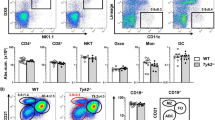Abstract.
It is well established that the activity and proliferation of lymphoid cells and lymphoid organs are stimulated by growth hormone. These actions on lymphoid cells may be direct or mediated by actions on the epithelial and non-immune tissue cells that regulate immune function. The occurrence and cellular localization of growth hormone receptors in immune tissues has therefore been investigated to determine the target-sites of growth hormone action. Growth hormone receptor mRNA was first detected by Northern blotting in the spleen, bursa of Fabricius, and thymus of domestic fowl. In addition to the 4.4-kb transcript thought to encode the full-length growth hormone receptor, smaller transcripts of 2.8 kb and 1.0 kb, which may encode growth hormone-binding proteins, were also occasionally observed. Further analysis using the polymerase chain reaction revealed that mRNA sequences encoding the extracellular and intracellular domains of the growth hormone receptor were present in all tissues and highly homologous with hepatic transcripts. Translation of these transcripts also occurs in immune tissues, since immunoreactive growth hormone-binding proteins or growth hormone receptors of approximately 56 kDa were detected in hepatic, splenic, thymic, and bursal extracts. Immunocytochemistry of these tissues subsequently revealed that macrophages probably contain the bulk of this immunoreactivity, although some thymic medullary epithelial cells (including Hassall’s corpuscles) and splenic ellipsoids and interdigitating cells were also immunoreactive. This immunoreactivity is present in immune tissues of newly hatched and adult chickens. Importantly, B-lymphocytes were rarely, if ever, immunoreactive, and T-lymphocytes containing growth hormone receptors or binding proteins were not observed. These results suggest that a number of primary (thymus and bursa) and secondary (spleen) lymphoid tissues in the chicken contain growth hormone receptors and are thus target-sites for growth hormone action. The distribution of growth hormone receptor/growth hormone-binding protein immunoreactivity in these tissues would further suggest that growth hormone plays a major role in macrophage proliferation and/or activity and may indirectly affect lymphocyte maturation and storage via effects on thymic and splenic stromal cells.
Similar content being viewed by others
Author information
Authors and Affiliations
Additional information
Received: 4 December 1995 / Accepted: 29 April 1996
Rights and permissions
About this article
Cite this article
Hull, K., Thiagarajah, A. & Harvey, S. Cellular localization of growth hormone receptors/binding proteins in immune tissues. Cell Tissue Res 286, 69–80 (1996). https://doi.org/10.1007/s004410050676
Issue Date:
DOI: https://doi.org/10.1007/s004410050676




